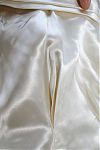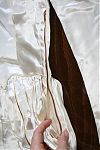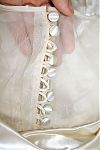My grandmother’s wedding dress arrived safely on Friday! I person, it’s absolutely jaw, droppingly gorgeous, even 59 years later. The preview photos I drew the technical drawing from didn’t do it justice, so I’m hoping these photos on James’s DSLR will help to show some of the amazing vintage details.
The dress is entirely silk satin with no lace, embroidery, or beading (just from a mesh panel around the neckline), and the weave of the silk is still perfectly and soft and so very strong still. Granny told me she bought this in a shop on South Street in Philadelphia in 1949, but I’m afraid I can’t tell you the designer as there’s no label and she’s long since forgotten the details. But the workmanship speaks for itself, and it’s very interesting for me to see that they’ve not wasted any silk where it couldn’t be seen – the mesh fabric is used for all facings, the seam allowances are only 1/2 inch, and there’s no lining.
Our table is 6 feet long and this dress uses the entire length of it, cascading for a good two feet past the end and at either side. She wasn’t lying – I’ll have a lot of material to work with when I reconstruct it. Forgive the lack of a proper full length photo – I want to show it off when it’s at its best after a proper cleaning and pressing, not after the poor dear has spant a week crossing the Atlantic in a tiny box…
If anything, I think the aged colour is actually more beautiful than a stark, bleached white. Though I am thankful I shouldn’t have to colour match any additional fabric at all!
The headpiece has these same flowers in a crown/tiara, and this brooch is detachable.
Gathered, piped, front waist seam:

The bust treatment on this gown is unlike anything I’ve ever seen before in a pattern – a vertical waist dart opens up into several pleats on both sides.
This zipper is the only opening on the dress, apart from the buttons on the back neck, which only go down as far as the collar at shoulder height:
Notice the tiny mesh facing at the sleeve edge. The edge of the sleeve ends in a point, which is off-centre to point to the ring finger on each hand, as is traditional. Even though these sleeves look absolutely tiny, I was actually able to get my arm in it up to the bicep, where my weight training makes my upper arms decidedly un-vintage in shape and muscle tone.
The back waist of the dress has a peplum which is constructed rather uniquely. Each side is a tube, open at the side seams and at the centre back, and lined with the mesh fabric. So I could stick my arm entirely through it and out the other side, and I’m guessing this was fluffed up to stand out from the body originally. The underside of the peplum has the same beautiful, piped seamwork as the front waist seam.
This was to allow my Granny to lift the heavy 3 foot train out of the way of her (and others’!) feet for the reception dancing! Notice how the clever seamstress cut the train pieces with the edges on the selvedge so that these wouldn’t fray as they dragged along the floor. The seams further up the skirt and in the bodice weren’t done in this way and have frayed slightly (nut not alarmingly so).
The only place where the bridal silk satin was used inside was where the mesh neck meets the off-the-shoulder collar, where these silk semicircles were placed. There’s no padding, so I’m not entirely sure of their purpose, really.
There are a few places where the stitching has come undone in the bust and sleeve seams, and there’s one small stain from the blue tissue paper it was wrapped in for 60 years (unfortunately placed at thigh height in the centre front skirt panel), but apart from that, the dress is in exceptional shape.
I’m afraid this is as much as you’re going to see of it for a while, though, as we’ve got a bit of major demolition and construction work coming up in the next few months. I’ve decided the dress is safer rolled up in its box (in white tissue paper this time!) the way it is so I’m not going to get it dry cleaned until after the dust has settled and I’m all set up in my new sewing room with enough space to hang it…
In other news, I’m now blogging for BurdaStyle! I’ve been a member of the site from even before it was live and running so it’s a great honour to be asked to regularly contribute! My first post went up last week, but I’ve got another in the works, too. I’m not anticipating repeating FehrTrade content, so make sure you subscribe to their RSS feed so you don’t miss anything…
















